Unpacking the CU@Home Engineering Kits
POSTED ON: October 12, 2020
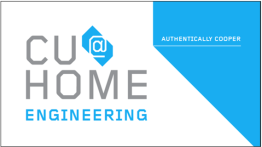
Adapting to the times when every course at the Albert Nerken School of Engineering is taught online, faculty, students, staff, and alumni worked together to develop packages of materials for several project-based courses.
Immediately following Spring Break 2020 and after our transition to online teaching due to the COVID-19 pandemic, Associate Dean Lisa Shay assembled and shipped components and parts to each student in her ECE150 Digital Logic Design (DLD) course in order to ensure that they each received the experience of the hands-on project. It was the success of this innovative pivot that was the beginning of CU@Home.
During the summer of 2020, as part of the Summer STEM DLD course, she and her innovative student instructors, Sophie Jaro EE ’22, Daniel Mezhiborsky EE ’23, and Jonathan Lu EE ’23 applied the same approach to create and ship project kits with nearly 200 components to high school students. Over the summer, faculty and staff worked diligently to prepare for the fall semester and those in several of our project-based courses envisioned similar project kits so even in an online modality, students would be able to build and test the project and thereby retain the rigor and authenticity of Cooper. In early June, faculty from the Department of Mechanical Engineering conceived of the branding “CU@Home” and within days, members of the Cooper Union Communications Department created the CU@Home branding.
The CU@Home project kits were made possible by donations from The IDC Foundation, Gene Briskman CE’64, and Vic DiFranco ChE’63.
A brief overview of the courses, project objectives and description of each CU@Home kit follows:
Electrical Engineering
ECE150 Digital Logic Design. The projects include design and prototype of digital circuits which are constructed and tested on breadboards.
ECE291 Sophomore Projects. Students investigate the design of subsystems that include amplifiers, oscillators, RF or optoelectronic circuits, A/D and D/A converters, and power circuits.
ECE393 Junior Projects. Students conduct circuit analysis and design with discrete and integrated electronic components and circuits. Projects provide an understanding of the fundamental building blocks employed in the more advanced designs in successive projects courses.
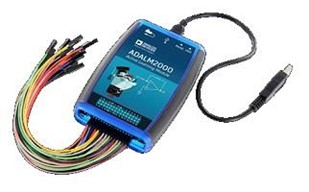
In addition to a breadboard and all components necessary, all freshmen, sophomores, and juniors (~90 EE students) received an Analog Devices ADALM 2000 (Figure 1), a USB-powered data acquisition module that connects to the student’s home computer. With 12-bit ADCs and DACs running at 100 MSPS, the ADALM2000 is capable of signal measurement up to 25 MHz and signal generation up to 30 MHz. The two power supplies can be adjusted in the ranges of 0 V to +5 V and –5 V to 0 V. The software can display a 2-channel oscilloscope and a 16-channel digital logic analyzer as well as a corresponding voltmeter. Networks, spectra, and digital buses can be analyzed.
EID102 Engineering Graphics.
Students receive an introduction to graphical representation of 3-dimensional objects. After learning the principles of technical drawing using precision hand tools, students utilize CAD software to create professional caliber engineering drawings. All freshmen (~140) received a T-square (Figure 2) with the CU@Home logo engraved on it.
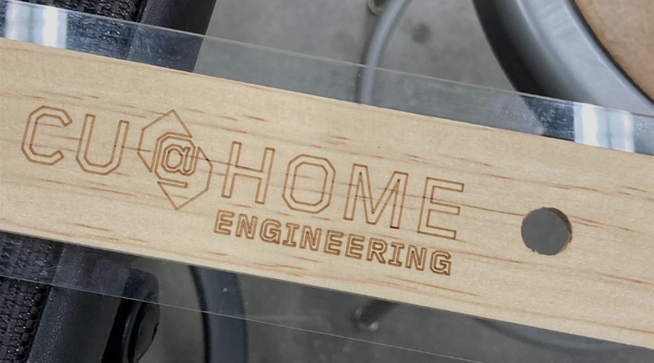
ME352 Process Control Laboratory.This kit (Figure 3) supports all junior ME students in the conduct of the process control laboratory. For ME352, students model the behavior of a DC motor and implement that model on the CU@Home apparatus. The CU@Home kit includes a custom apparatus along with an Arduino single-board microcontroller, a DC motor, encoder, and other components (Figure 4).
A modified apparatus will allow this kit to serve as the foundation for ME493 Drone Control Laboratory. The ME352 kit supports 21 juniors and ME493 9 juniors and seniors.

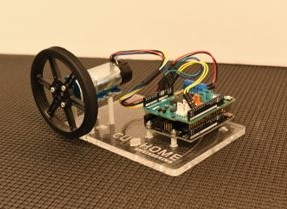
PH291 Introductory Physics Laboratory.
Experiments in this laboratory-based course test and apply basic principles selected from mechanics, sound, electromagnetism, optics, and modern physics. All sophomores (~140) received this kit.
EID101 Engineering Design and Problem Solving.
In our freshman engineering course, students work on exploratory design projects in interdisciplinary groups. This year, EID101 has been reimagined, integrating a consistent design process across all six sections with common milestones, deliverables, and rubrics. The addition of student mentors to project teams will also encourage community building as the mentors will provide support and technical assistance. Several of the six sections of EID101 will incorporate CU@Home kits. Students in one section, focusing on hydroponics, will build a functioning hydroponic station (Figure 5) with local communication capability. The CU@Home kit includes an ESP8266 microcontroller with Wi-Fi connectivity, a temperature and humidity sensor, and a gas sensor. Another section, focused on smart cities, includes both the hydroponic kit as well as a robotic vehicle kit (Figure 6) to teach about autonomous navigation. This kit includes an Arduino microcontroller, ultrasonic sensor, accelerometer, and IR interrupt encoders. These two sections of EID101comprise a total of ~50 freshmen.
We gratefully acknowledge the generous contributions of Gene Briskman CE’64 in support of the EID101 course.
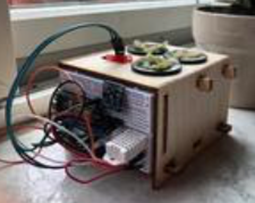
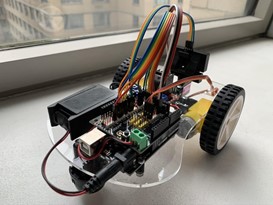
EID222 Biomaterials.
Students complete three laboratory experiments related to metals, ceramics, and polymers. The metal experiment focuses on corrosion and fatigue failure, an important aspect of metallic biomaterial design. The ceramic experiment demonstrates the principle of impact testing and brittle failure are explored for ceramic biomaterials. In the polymer experiment, students explore the mechanical properties, specifically stiffness, of different hydrogel composites. A mixture of 27 sophomores, juniors, and seniors received this CU@Home kit.




